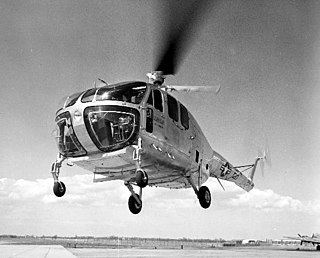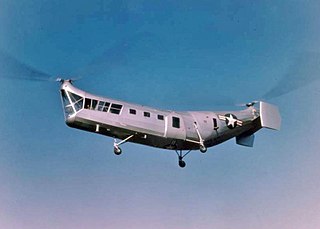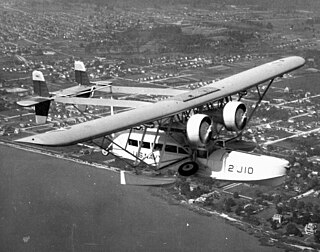
The Douglas Dolphin is an American amphibious flying boat. While only 58 were built, they served a wide variety of roles including private air yacht, airliner, military transport, and search and rescue.

The Cessna 310 is an American four-to-six-seat, low-wing, twin-engine monoplane produced by Cessna between 1954 and 1980. It was the first twin-engine aircraft that Cessna put into production after World War II.

The Vought SBU-1 Corsair was a two-seat, all-metal biplane dive bomber built by Vought Aircraft Company of Dallas, Texas for the US Navy. Its design was based upon the F3U-1 two-seat fighter that was abandoned when the Navy decided not to obtain any more two-seat fighters.

The Cessna 421 Golden Eagle is an American six or seven seat twin-engined light transport aircraft, developed in the 1960s by Cessna as a pressurized version of the earlier Cessna 411.

The Lockheed Altair was a single-engined sport aircraft of the 1930s. It was a development of the Lockheed Sirius with a retractable undercarriage, and was the first Lockheed aircraft and one of the first aircraft designs with a fully retractable undercarriage.

The Vought O2U Corsair was a 1920s biplane scout and observation aircraft. Developed by Vought Corporation, the O2U was ordered by the United States Navy (USN) in 1927. Powered by a 400 hp (298 kW) Pratt & Whitney R-1340 engine, it incorporated a steel-tube fuselage structure and a wood wing structure with fabric covering. Many were seaplanes or amphibians.

The Boeing P-29 and XF7B-1 were an attempt to produce a more advanced version of the highly successful P-26. Although slight gains were made in performance, the U.S. Army Air Corps and U.S. Navy did not order the aircraft.

The Bell R-12 was an American 1940s military utility helicopter built by the Bell Helicopter company.

The Consolidated O-17 Courier was an observation and training aircraft used by the United States National Guard.

The Fairchild AT-21 was an American World War II specialized bomber crew trainer, intended to train crews in the use of power gun turrets or a gun on a flexible mount, as well as learn to function as a member of a crew. It had a brief career as a training aircraft before modified bombers took over this role.

The Grumman XSBF, also known by the company designation G-14, was an American biplane scout bomber developed by Grumman Aircraft for the United States Navy during the 1930s. Derived from Grumman's successful "Fifi" fighter, the aircraft was developed at a time when the biplane was giving way to the monoplane. In competition against other aircraft it proved to possess inferior performance in its intended role, and did not enter production. The sole prototype went on to serve as a liaison aircraft, as well as being used in experiments by NACA, before being destroyed in a crash in 1939.

The Loening OL, also known as the Loening Amphibian, was an American two-seat amphibious biplane designed by Grover Loening and built by Loening for the United States Army Air Corps and the United States Navy.

The Keystone LB-6 and LB-7 were 1920s American light bombers, built by the Keystone Aircraft company for the United States Army Air Corps, called Panther by the company, but adoption of the name was rejected by the U.S. Army.

The Thomas-Morse O-19 was an American observation biplane built by the Thomas-Morse Aircraft Company for the United States Army Air Corps.

The Piasecki HRP Rescuer is a United States tandem-rotor transport or rescue helicopter designed by Frank Piasecki and built by Piasecki Helicopter. The Piasecki PV-3 was adopted as the HRP-1 Rescuer by the United States Navy, United States Marine Corps, and United States Coast Guard. An improved PV-17 variant was later produced as the HRP-2. As one of the first transport helicopters in military service, the HRP-1 was capable of carrying two crewmen and 8-10 passengers or 2,000 lb. (907 kg) of cargo.

The Boeing AT-15 was an American twin-engined bomber crew trainer designed and built by Boeing's Wichita Division. Only two prototypes, designated XAT-15, were built. Plans to build over 1,000 were cancelled on the United States' entry into the Second World War.

The Fairchild 100 Pilgrim is an American single-engined high-wing monoplane transport, and was one of a series of single-engine utility transports built by Fairchild Aircraft.

The Stearman XBT-17 was a prototype 1940s American two-seat low-wing monoplane primary trainer designed and built by Stearman Aircraft. It was evaluated by the United States Army Air Force in 1942 as the XBT-17.

The McDonnell XHJH Whirlaway, aka McDonnell Model 65, was a 1940s American experimental twin-rotor helicopter designed and built by McDonnell Aircraft Corporation for the United States Navy and was the largest helicopter at the time, as well as the first successful twin-engined twin-rotor helicopter in the world.

The Sikorsky S-41 was an amphibious flying boat airliner produced in the United States in the early 1930s. Essentially a scaled-up monoplane version of the Sikorsky S-38 biplane flying boat, Pan Am operated the type on routes in the Caribbean, South America, and between Boston and Halifax.




















